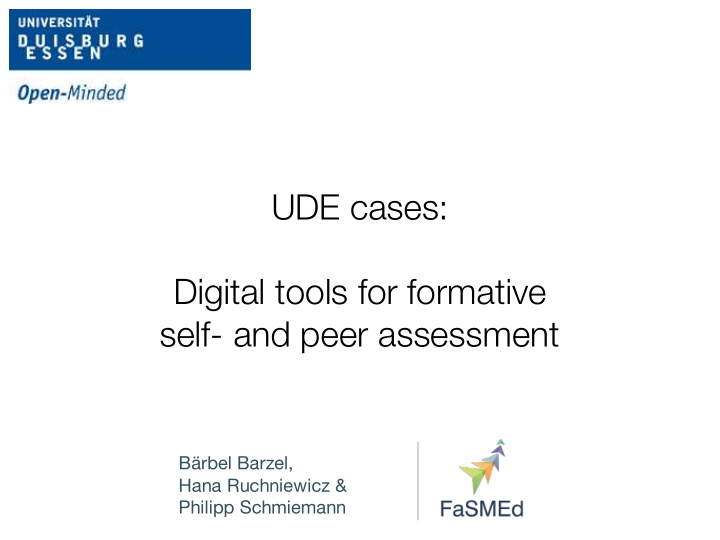



UDE cases: Digital tools for formative self- and peer assessment Bärbel Barzel, Hana Ruchniewicz & Philipp Schmiemann
Who we worked with and what we did (Maths) 10 teachers, 4 secondary schools Evaluation of first pen&paper version of tool (Dez14 – Apr15): 3 single student interviews (grade 8, 13-15 years) − 4 partner student interviews (grade 8, 13-15 years) − Expert review with 23 colleagues at DUE − Re-Design: second pen&paper version Implementation of Technology: Sept14-May15: JACK & TI-Nspire Prototypes − Mar15: collaboration with Steve Arnold − Aug15: first test with 16 students (grade 10, 16-18 years) − Dez15: TI-Nspire version finalized − Case Study: 28 students (grade 10, 16-18 years) − 2 single student interviews −
Digital tool for formative self-assessment: „Can I sketch a graph based on a given situation?“ Test Check Structure:
Reconstruction of formative assessment processes: Student‘s (grade 10, age 16) solution to the Test -task: First Check-point: „I realized that the graph reaches the value of zero three times.“ S does not mark off the Check-point (identifies a mistake)
Reconstruction of formative assessment processes: S continues with Info 1 and reflects her mistake: „I did not do it like this, I did it so that Niklas rides along the street (points to the first increasing part of the graph) and then here (points to the first segment of the graph that remains constant) he rides along the hill and then he stops, but I did not do it with the second zero, when Niklas stands on top of the hill then he has no speed anymore.“
Reconstruction of formative assessment processes: The student: understands criteria for success, • (marking off check-points) elicits evidence of own understanding. • (work on tasks, identification of mistake, comparison of own solution to sample solution) formulates a self-feedback, • (reflection on own solution) is activated as the owner of her learning • (challenge to reflect own work, decisions on which steps to take next)
Reconstruction of formative assessment processes: Characterisation of the formative assessment process:
Science Case School context: - Gesamtschule (comprehensive school) - grade 7 (12-14 years) Scientific context: “Who has the juiciest apple?” - surface-to-volume ratio - evaporation protection - experiment
Who we worked with and what we did (Science) Material development: • Feedback process of materials via phone and mail with teachers Work with interested teachers: • Introduction Workshop at DUE (10 participating teachers) Case Study Implementation: • Preliminary meeting at case study school (2 teachers) • Case Study & Student interview • Teacher interview
Digital tool for formative self- and peer assessment: PowerPoint presentation: • Interactive • Simplifies hyperlink structure • Illustrations • Further definitions
Digital tool for formative self- and peer assessment: EXPERIMENT FaSMEd A1 Can I Propose a hypothesis to the given problem? Diagnostic task for The students of the seventh class are doing a school each experimental step excursion in the mountains. Bahri and Sandra got wrapped apples as supplies from their mothers. Bahri doesn’t like the bitter skin so his apple is already peeled. Sandras’ mother however has cut him his peeled apple into bite-sized pieces. During the day the temperature rises to 35°C in the shade. Who is going to have the juiciest apple in the afternoon? FaSMEd Solution A1 Propose a presumption for the stated problem. A propose is also called a hypothesis! For this specific problem you can propose the hypothesis in various ways. (It doesn’t matter if your hypothesis turns out to be wrong at the end of the experiment.) How did you proceed? How did you proceed? Self- or peer I didn´t know what to find out. (A1.2) I´ve set up a scientific presumption. assessment (A2) I was unable to propose any scientific presumption. (A1.1)
Digital tool for formative self- and peer assessment: Good to know Self- or peer assessment FaSMEd GTK A1.2 FaSMEd Solution A1 Imagine you are getting a cut apple from your mother to school. Unfortunately you forgot to eat it so you find the apple after a week in your schoolbag. The apple pieces are now already shriveled and collapsed. So they also became lighter. This process has already begun on the first day. Sometimes it’s difficult to discover these For this specific problem you can propose the hypothesis in various differences in the first few minutes. ways. (It doesn’t matter if your hypothesis turns out to be wrong at the end of By using a balance you can determine the weight repeatedly. Please the experiment.) note that the balance must be set correctly. How did you proceed? How did you proceed? Diagnostic Task I didn´t know what to find out. (A1.2) I´ve set up a scientific presumption. (A2) EXPERIMENT FaSMEd A2 I was unable to propose any scientific What are the experimental approches? presumption. (A1.1) After your first scientific presumption you may now design your experiment. For your first preparations you need two experimental approches: • If X is present, then something happens. • If X is not present, then something different happens. As a scientist you re now planning an experimental approaches, in which this factor X is present, and another approach, where the factor is missing. Afterwards the different results after your experiment will show you the effect of this factor. Which one is your chosen variable in this experiment?
Implementation In general: • Positive feedback regarding concept, implementation, interaction and support • Motivation due to independence, technology and experiments Teacher: • Would like to have more self-diagnostic assessment materials • Reduced work load due to structured lesson plan and material Student: • Appreciated possibility to follow their Own learning path • Emphasized independence of work
Recommend
More recommend